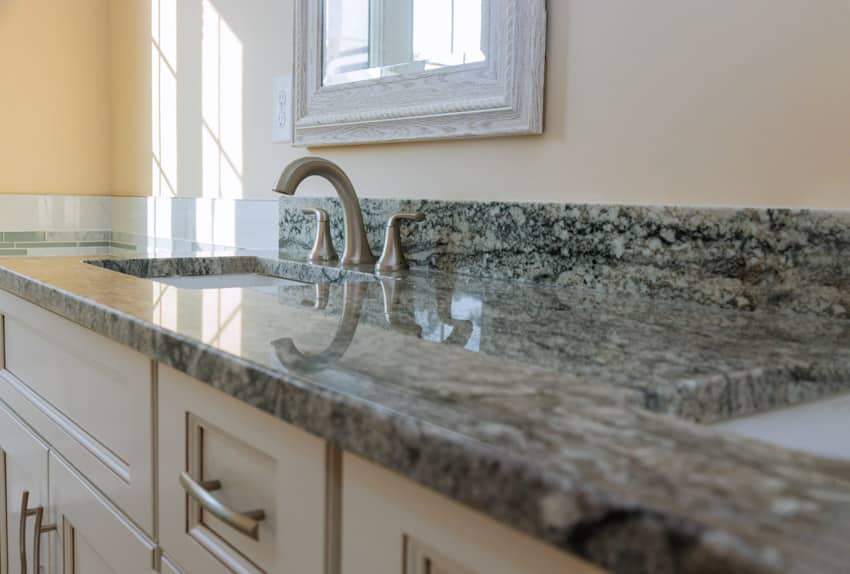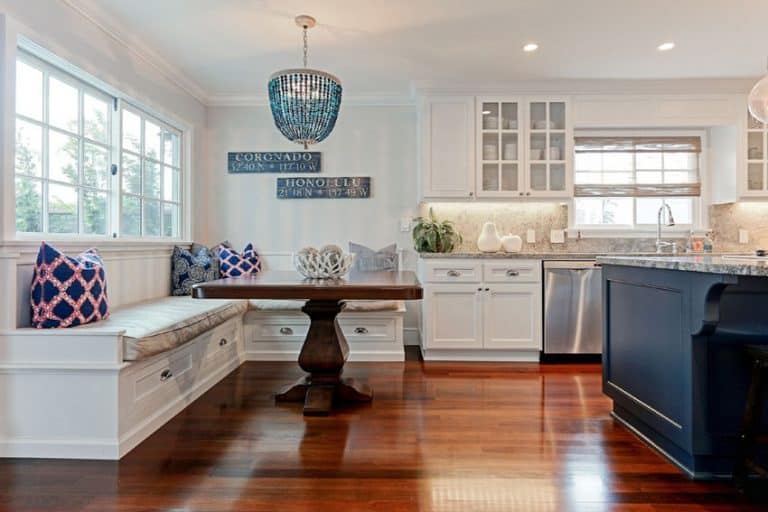How To Seal Granite Countertops: Application Tips

If you have beautiful granite countertops and want to keep them looking like they belong in a show house, you may need to seal them. Some countertops are pre-sealed, but if yours isn’t (or you are unsure), don’t wait to give it the protection it needs. Improperly cleaning spills left unattended and other regular daily usage might quickly degrade the surface areas. To prevent damage, use a penetrating (or impregnating) sealant that soaks into the granite and fills the porous crevices to prevent damage.
True, a sealer only buys you time—unattended spills can ultimately leak through sealed surfaces—but the appropriate one will undoubtedly help safeguard your investment. Water-based sealants are better for the environment, but solvent-based sealants may penetrate deeper into the stone—though this is probably only essential on polished granite. Look for the active component “fluorocarbon aliphatic resin” on the labels of water- or solvent-based sealants.
Though more expensive than sealants containing siloxane and silicone, fluorocarbon aliphatic resin will give protection for five to ten years, compared to six months to three years for other sealants. Furthermore, fluorocarbon aliphatic resins resist oil and water so that a salad dressing spill won’t harm your granite.
Depending on the manufacturer, a quart of fluorocarbon aliphatic resin sealer costs about $35 and covers 150 to 250 square feet. A 24-ounce spray container of less powerful solvent costs around $15, but it may need reapplication every six months or so.
You will find comprehensive instructions for sealing granite countertops, but precise procedures may differ depending on the brand and active components. For the most significant results, be sure to follow the sealant’s label directions as well as some helpful hints.
Tools Needed To Seal Granite
- Granite sealer
- Microfiber cloths
- Liquid dishwashing detergent
- Spray bottle
- Isopropyl
- Rubbing alcohol
- Rubber gloves
- Soft rags
How to Choose A Granite Countertop Sealant
Once you have installed your perfect kitchen countertop, it is time to consider upkeep. Yes, granite doesn’t need much upkeep, but did you know that it requires sealing now and then? Granite, particularly light-colored stones, is porous by nature.
What is the purpose of a granite sealer? Sealants for granite countertops are not the same as sealants for hardwood surfaces. Unlike sealing the different types of hardwood floors or surfaces with varnish. On the other hand, granite sealing solutions penetrate the stone and fill up the pores, safeguarding the surface from the inside. Using a sealer does not make the stone shine and it will look beautiful on its own.
Why do they require a sealant? Applying a sealer does not make the stone resistant to scratches or scuffs, even if you choose the most refined product available. Granite is one of the world’s hardest stones, and it is inherently resistant to physical harm. When the sealer impregnates the stone, it fills the pores and makes the surface impervious to liquids and stains.
Most dark granite colors for countertops do not need a sealer because of their density. Because these stones are so thick, they don’t easily absorb liquids. Applying a sealer to these areas will only harm the stone by making the countertop surface “filmy” and ruining the shine. As a result, most light-colored granite countertops need sealing. However, there is a simple test you can do to be sure.
The “drop test” involves dropping water or lemon juice on an inconspicuous area of your tabletop. Leave the drop on the counter and watch how quickly it absorbs the liquid.
There are so many sealing solutions on the market today that choosing the most refined sealer may be challenging. But which is the best?
According to our criteria, the SenGuard DIY Sealer Kit is the best solution to use. The SenGuard sealer should be your first choice if money isn’t an issue. The package includes an impregnating seal, an instructional DVD, and a one-time seal warranty. And most important, you don’t need to be a professional to use it.
You can also use the MB Stone Sealer. The seal often lasts far longer and is much more robust than other so-called stone sealers on the market.
When shopping for the best granite sealer, keep the following traits in mind:
• Stone impregnation ability
• The seal’s durability
• Reapplication/maintenance frequency
How to Apply Granite Stone Sealer
Here we share a simple process that will help you seal your granite countertops.
1. Test your surface to see whether it needs sealing.
2. Use acetone or a premium granite cleaner to remove any dirt or residues from the surface.
3. Apply enough sealer to cover a small, manageable area (not the entire countertop).
4. Using a paintbrush or a clean cloth, apply a thin, equal layer of sealer all over the surface.
5. Allow 2-5 minutes for the sealer to soak into the stone (time depends on the specific stone and sealer).
6. To ensure complete coverage, pour on a little more sealer, spread it around, and let it sit for another minute or two after the thin film of sealer has absorbed and the area has begun to dry.
7. After that, wipe up any leftover sealer with a clean, dry cloth and buff the surface fully dry (essential) to prevent a difficult-to-remove haze after sealing.
Additional Sealer Application Tips
Granite must absorb enough sealant to be successful. It will still stain if you don’t do so. As a result, pouring and spreading are significantly more effective than wiping or spraying.
Spraying a little sealer on the surface and then wiping it off (as some people propose online) is utterly ineffective. Even if you use this procedure regularly, it will not seal your counters. The sealing product is a terrible waste of effort and money.
It could work if you spray and spray and spray until you have enough sealer on the surface to form a thin coating. It will give you an excellent forearm exercise or a hand cramp, and it will take you longer to finish than pouring on and spreading.
The same goes for wetting a towel and wiping it around. There isn’t enough sealer applied to the stone surface. Remember to apply enough sealer to the surface to soak the stone thoroughly. You do it by applying a thin, uniform coat of sealant.
If a haze forms, apply a tiny amount of sealer to the affected area, rub with a cloth, and wipe dry entirely. The longer you wait, or the longer the sealer residue is left to dry and cure, the more difficult it will be to remove the haze.
How To Tell If Granite is Sealed (Water Test)
The water test is a fast and easy technique to verify the seal on your granite countertop. Pour a small quantity of water (about 3 inches in diameter) over different parts of the counter and wait for a response. If the stone absorbs the water, it will become darker. When doing the test, let the water soak for 30 minutes.
If your granite darkens before the 30 minutes are over, you should seal it immediately. The stone either has no stain protection and will absorb cleansers or any liquids spilled on it, or the present sealer is worn down and provides minimal protection.
If the surface does not discolor after 30 minutes, it has a firm seal that provides good protection. It is entirely normal for the sealer to enable water to infiltrate the stone over time, but a puddle of water should take at least 30 minutes to darken.
You can’t over-seal granite or other natural stone, so even if your countertops pass the water test, it is not a bad idea to reseal them. Many homeowners protect their surfaces every year. Sealing ensures long-term resistance to etching, stains, and dirt accumulation.
Once you seal the counters, be sure to clean them periodically with a specially designed cleaner and shine them with a safe-on-stone polish. Granite and other forms of natural stone need regular maintenance, and it’s critical to choose chemicals that won’t damage the stone.
How Often To Seal Your Granite
Granite is a one-of-a-kind natural stone that is incredibly durable, heat resistant, and simple to clean. If not correctly cared for it may discolor and deform over time. It would help if you provide this application to prevent them from losing their visual appeal.
You will determine the sealing frequency by its absorbency and porosity. The lighter the stone, the more often you must seal it. However, not all stone surfaces are created equal, and applying sealer regularly or “just to be safe” is not a good idea. When sealer is applied too quickly and does not have enough time to soak, it may create a haze on the surface that is difficult to remove.
It is advisable to test your granite countertop first to check whether resealing is essential before deciding when to reseal it. Some professionals recommend that you should seal granite countertops every “6-12 months” or “3-5 years,” but there is no hard and fast rule.











